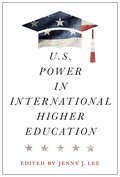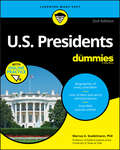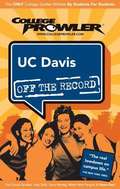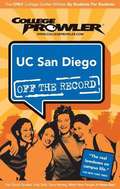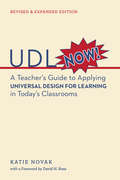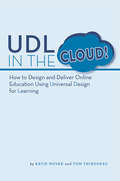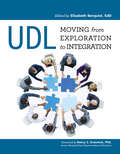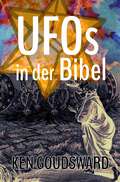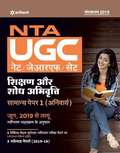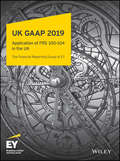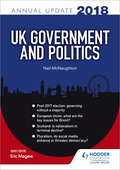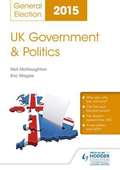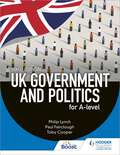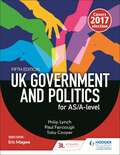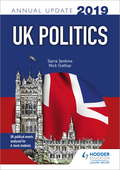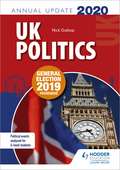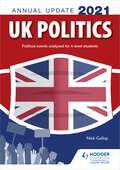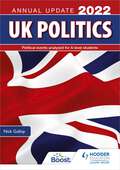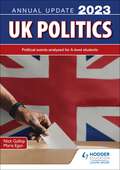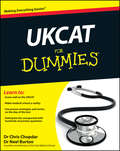- Table View
- List View
U.S. Power in International Higher Education
by Roopa Desai Trilokekar Ellen Hazelkorn Brendan Cantwell Jenny J. Lee Gerardo L. Blanco John P. Haupt Chrystal A. Mwangi Sean Jung-Hau Chen Pempho Chinkondenji Dale LaFleur Christina W. Yao Chris R. Glass Sharon Stein Santiago Castiello-GutiérrezU.S. Power in International Higher Education explores how internationalization in higher education is not just an educational endeavor, but also a geopolitical one. By centering and making explicit the role of power, the book demonstrates the United States’s advantage in international education as well as the changing geopolitical realities that will shape the field in the future. The chapter authors are leading critical scholars of international higher education, with diverse scholarly ties and professional experiences within the country and abroad. Taken together, the chapters provide broad trends as well as in-depth accounts about how power is evident across a range of key international activities. This book is intended for higher education scholars and practitioners with the aim of raising greater awareness on the unequal power dynamics in internationalization activities and for the purposes of promoting more just practices in higher education globally.
U.S. Presidents For Dummies with Online Practice
by Marcus A. StadelmannDiscover how the Oval Office’s occupants have made and make history Which one was the tallest? Which one fought a duel? Which had liquor smuggled into the White House during Prohibition? And why is the president even called the president in the first place? From periwigs and knee breeches to the 24-hour news cycle and presidential Tweets, the fascinating and colorful stories of the 45 incumbents are a powerful lens through which to view U.S. history and get insight into the present. Taking readers on a fact-filled journey through two centuries, this book examines how each individual obtained their dream (or nightmare) position, what they stood for (or against), achieved (or didn’t), and how their actions affected the country—for better or worse. And—remembering that presidents are people too—it shows how the personal really can be political, exploring how each president’s vision, strengths, and foibles helped or hindered them in building the country and their own legacy. Accessible biographies of all presidents Sidebars, timelines, and photos Lists of best and worst administrations Bonus online content, including quizzes galore to help build retention Whether you’re a student, a history buff—or are even interested in becoming president yourself one day—U. S. Presidents For Dummies is the perfect guide to what it takes to be leader of the free world, who has stepped up to that challenge, and how those personal histories can help us understand yesterday’s, today’s, and even tomorrow’s union.
UC Davis (College Prowler)
by Tristen ChangNo university affiliations. No half-truths. No out-of-touch authors who haven't been in school for decades. A class project turned company, College Prowler produces guidebooks that are written by actual college students and cover the things students really want to know. Unlike other guides that jam everything into a five-pound book and devote only two pages to each college, our single-school guidebooks give students only the schools they want and all the information they need. From academics and diversity to nightlife and sports, we let the students tell it how it is. In addition to editorial reviews and grades for 20 different topics, more than 80 percent of each guide is composed of actual student reviews of their school. Whether readers are looking for "Best and Worst" lists, "Did You Knows?" or traditions, College Prowler guides have it all. Our books are the only place for local slang, urban legends, and tips on the best places to find a date, study, or grab a bite to eat.
UC San Diego (College Prowler)
by Shelby GundermanNo university affiliations. No half-truths. No out-of-touch authors who haven't been in school for decades. A class project turned company, College Prowler produces guidebooks that are written by actual college students and cover the things students really want to know. Unlike other guides that jam everything into a five-pound book and devote only two pages to each college, our single-school guidebooks give students only the schools they want and all the information they need. From academics and diversity to nightlife and sports, we let the students tell it how it is. In addition to editorial reviews and grades for 20 different topics, more than 80 percent of each guide is composed of actual student reviews of their school. Whether readers are looking for "Best and Worst" lists, "Did You Knows?" or traditions, College Prowler guides have it all. Our books are the only place for local slang, urban legends, and tips on the best places to find a date, study, or grab a bite to eat.
UDL Now!: A Teacher's Guide to Applying Universal Design for Learning in Today's Classrooms
by David Rose Katie NovakIn this revised and expanded edition of UDL Now! Katie Novak provides practical insights and savvy strategies for helping all learners meet high standards using the principles of Universal Design for Learning (UDL). UDL is a framework for inclusive education that aims to lower barriers to learning and optimize each individual's opportunity to learn. Novak shows how to use the UDL Guidelines to plan lessons, choose materials, assess learning, and improve instructional practice. Novak discusses key concepts such as scaffolding, vocabulary-building, and using student feedback to inform instruction. She also provides tips on recruiting students as partners in the teaching process, engaging their interest in how they learn. UDL Now! is a fun and effective Monday-morning playbook for great teaching.
UDL in the Cloud!: How to Design and Deliver Online Education Using Universal Design for Learning
by Katie Novak Tom ThibodeauUDL in the Cloud helps educators design and deliver more accessible, engaging, and effective online learning experiences. Drawing on years of experience in K-12 and postsecondary settings, authors Katie Novak and Tom Thibodeau offer a highly practical approach to developing e-courses, virtual snow days, flipped classes, and blended learning experiences that meet the needs of diverse learners.
UDL: Moving from Exploration to Integration
by Elizabeth Berquist Nancy S GrasmickThis is the first book to consider scaled-up implementation of Universal Design for Learning in schools, districts, and even states. In this collections of case stories, veteran educators and administrators share their stories, tips, and lessons learned from implementing UDL in a variety of settings. Elizabeth Berquist, a leading voice in the burgeoning UDL field, edits and contributes to the collection. In addition to specific strategies for scaling up UDL, the book provides ideas for improving teacher professional development and classroom practice.
UFOs in der Bibel: UFOs in der Bibel
by Ken GoudswardUralte Wahrheiten, die seit Tausenden von Jahren vor aller Augen verborgen sind. Im Jahr 1968 brach Erich von Däniken eine Tür auf, durch die Millionen von Neugierigen mit Verwunderung und möglicherweise auch etwas Fassungslosigkeit geschaut haben. Jetzt, auf den Schultern dieses Riesen stehend, wird die Tür von Ken Goudsward in dieser erstaunlichen neuen Untersuchung der Heiligen Schrift weit aufgestoßen, wobei er eine beispiellose hebräische Exegese nutzt, um nicht weniger als 30 außerirdische Begegnungen auf den Seiten des meistverkauften Buches aller Zeiten zu enthüllen. In einer Zeit des Scheidewegs zwischen Enthüllung und Verschwörung war die Bibel noch nie so relevant wie heute.
UGC NET JRF SLET - General Paper 1 - Shikshan Aur Shodh Abhivrutti: यू.जी.सी नेट/जेआर एफ/सेट - सामन्य पेपर 1 - शिक्षण और शोध अभिवृत्ती
by Arihant Limitedशिक्षण और शोध अभिवृत्ती सामन्य पेपर 1 अरिहन्त पब्लिकेशन्स (इण्डिया) लिमिटेड ने पुस्तक हिंदी भाषा में प्रकाशित किया गया है, इस पाठ्यक्रम के अनुसार 10 इकाइयों (शिक्षण अभिवृत्ति, शोध अभिवृत्ति, बोध, सम्प्रेषण, गणितीय तर्क और अभिवृत्ति, युक्तियुक्त तर्क, आँकड़ों की व्याख्या, सूचना एवं संचार प्रौद्योगिकी, लोग, विकास एवं पर्यावरण तथा उच्च शिक्षा प्रणाली) में विवरण की व्याख्या की गई है । पुस्तक में विद्यार्थियों को समझाने के लिए सरल भाषा के साथ जगह-जगहें पर उदाहरण, फ्लोचार्ट, चित्र, एवं नवीन तथ्यों इत्यादि का समावेश किया गया है तथा वर्ष 2018 (दिसम्बर और जुलाई) के हल प्रश्न-पत्रों को विस्तृत व्याख्या के साथ दिया गया है।
UK GAAP 2019: Generally Accepted Accounting Practice under UK and Irish GAAP
by Ernst & Young LLPUK GAAP 2019 provides a comprehensive guide to interpreting and implementing UK accounting standards, particularly: FRS 100: Application of Financial Reporting Requirements FRS 101: Reduced Disclosure Framework — Disclosure exemptions from EU-adopted IFRS for qualifying entities FRS 102: The Financial Reporting Standard applicable in the UK and Republic of Ireland FRS 103: Insurance Contracts FRS 104: Interim Financial Reporting This book is an essential tool for anyone applying, auditing, interpreting, regulating, studying or teaching those accounting standards. Written by the financial reporting professionals from the Financial Reporting Group of EY, this book provides a clear explanation of the UK GAAP accounting requirements which apply in 2019 and will prove invaluable in implementing these requirements. It also addresses the requirements of the UK Companies Act and relevant statutory instruments, as well as practical worked examples. Also available is International GAAP® 2019 — a three volume comprehensive guide to interpreting International Financial Reporting Standards (IFRS), setting IFRS in a relevant business context and providing insight into how complex practical issues should be resolved in the real world of global financial reporting.
UK Government & Politics Annual Update 2018
by Neil McNaughtonTopical reading essential for exam success.- Review all the key developments in UK politics from the last year, with expert analysis you can draw on both throughout your course and in the exams- Go beyond your textbooks to build a bank of up-to-date examples and data, helping you develop knowledgeable and persuasive arguments- Know how to hit the highest grades with guidance from experienced teachers and authors, Neil McNaughton and Eric MageeContentsChapter 1: The 2017 general election: an earthquake or just a tremor?Chapter 2: After the 2017 general election: governing without a majorityChapter 3: City and regional mayors: how much power do they really have?Chapter 4: The Central Executive: what happened to collective responsibility?Chapter 5: Pluralism: Does social media enhance or threaten democracy?Chapter 6: The Supreme Court: is it too powerful?Chapter 7: Pressure groups: three contemporary case studies (the Fawcett Society, the Taxpayers' Alliance, UK Finance)Chapter 8: Time for a British Bill of Rights?Chapter 9: European Union: what are the key issues for Brexit?Chapter 10: Scotland: is nationalism in terminal decline?
UK Government & Politics: General Election 2015
by Eric Magee Neil McnaughtonFull coverage and analysis of possibly the most significant, and certainly most interesting, election in modern times.Written by an experienced teacher and examiner, and edited by an acknowledged expert in the field of UK politics, this update provides you with topical material to draw on for tasks throughout your course, and for answering examination questions.- Examines the parties' election campaigns, manifestos and policies - Reviews and explains the results, as well as looking at the task ahead for the new government- The perfect update for your textbook, bringing you right up to date with all the topical material you need to achieve your best in your examsTopics covered:- a comparison of the party manifestos- the impact of the televised debates- the result: who won, who lost, and why- the formation of the new government- the emerging new party system- whether the first-past-the-post electoral system can survive- how the result will affect the devolution debate- where now for UK politics?toral system can survive - how the result will affect the devolution debate - where now for UK politics?
UK Government and Politics for A-level Sixth Edition
by Eric Magee Paul Fairclough Philip Lynch Toby Cooper- Comprehensive coverage and analysis of relevant political developments helps develop students' knowledge and key skills-Up-to-date examples, case studies and debate feature will improve students' grasp of contemporary developments in UK politics-Includes more synoptic links to help students understand how different topics within the A-level link together -Includes quickfire knowledge-check questions and summaries of key content to help consolidate knowledge and understanding -Features exam-style questions throughout, helping students improve their analysis and evaluation skills-Provides answer guidance for exam-style questions online at www.hoddereducation.co.uk/xxx
UK Government and Politics for A-level Sixth Edition
by Eric Magee Paul Fairclough Philip Lynch Toby Cooper- Comprehensive coverage and analysis of relevant political developments helps develop students' knowledge and key skills-Up-to-date examples, case studies and debate feature will improve students' grasp of contemporary developments in UK politics-Includes more synoptic links to help students understand how different topics within the A-level link together -Includes quickfire knowledge-check questions and summaries of key content to help consolidate knowledge and understanding -Features exam-style questions throughout, helping students improve their analysis and evaluation skills-Provides answer guidance for exam-style questions online at www.hoddereducation.co.uk/xxx
UK Government and Politics for AS/A-level (Fifth Edition)
by Paul Fairclough Philip Lynch Toby CooperDownload a pre-election eInspection copy today, to start your lesson planning for September 2017.Inspire political thinking with our bestselling politics textbook, fully updated the new 2017 specifications. Help students get their best grade with political commentary and analysis; the final edition of the book will include coverage of the June 2017 general election results.Covering key topics for all exam boards, this textbook puts politics in context with topical analysis of politics today and how UK governmental and political history shaped current events and thinking.- Extend knowledge and improve key skills with comprehensive coverage and analysis of relevant political developments, including possible consequences of Brexit, such as its effect on Scottish independence- Understand how different topics within the A-level link together with the new Synoptic Links feature- Develop key analysis and evaluation skills with activities and case studies throughout the textbook - look out for Debate, Case Study and Activity boxes- Clarify knowledge and understanding of political language with summaries and explanations of key terms- Test and develop understanding of key topics with exam focus sections tailored to the new Politics specifications
UK Government and Politics for AS/A-level (Fifth Edition)
by Paul Fairclough Philip Lynch Toby CooperExam Board: AQA, Edexcel, OCR & WJECLevel: A-levelSubject: PoliticsFirst Teaching: September 2017First Exam: June 2018Inspire political thinking with our bestselling politics textbook and help students get their best grade with political commentary and analysis; , fully updated the new 2017 specifications and including coverage of the June 2017 general election results.Covering key topics for all exam boards, this textbook puts politics in context with topical analysis of politics today and how UK governmental and political history shaped current events and thinking.- Extend knowledge and improve key skills with comprehensive coverage and analysis of relevant political developments, including the 2017 snap election, possible consequences of Brexit, and its effect on Scottish independence- Understand how different topics within the A-level link together with the new Synoptic Links feature- Develop key analysis and evaluation skills with activities and case studies throughout the textbook - look out for Debate, Case Study and Activity boxes- Clarify knowledge and understanding of political language with summaries and explanations of key terms- Test and develop understanding of key topics with exam focus sections tailored to the new Politics specifications
UK Politics Annual Update 2019
by Sarra Jenkins Nick Gallop- Review all the key developments in UK politics from the last year, with expert analysis you can draw on both throughout your course and in the exams- Go beyond your textbooks to build a bank of up-to-date examples and data, helping you developknowledgeable and persuasive arguments- Know how to hit the highest grades with guidance from experienced teachers and authors Sarra Jenkins and Nick Gallop
UK Politics Annual Update 2020
by Nick GallopThis course companion offers you all the information, analysis and topical material you need to draw on for tasks throughout your course, and for answering examination questions.- Review all the developments relevant to A-level specifications in UK politics from the last year, with examples linked closely to specification points- Develop your confidence with expert analysis you can draw on both throughout your course and in the exams- Enhance your knowledge of the news to build a bank of up-to-date examples linked to the specifications, helping you to develop persuasive arguments for your essays- Learn to hit the highest grades with guidance from experienced author, teacher and Politics Review editor Nick GallopChapters include coverage on:- The 2019 general election- Relations between Parliament and the Executive - Relations between the Prime Minister and the Cabinet- Brexit and the constitution- 20 years of devolution
UK Politics Annual Update 2021
by Nick GallopYou can use this Annual Update for tasks throughout your course and for help with examination questions.- Review all the developments relevant to A-level specifications in UK politics from the last year, with examples linked closely to specification points, strong links between topics and focused suggestions for further reading- Develop your confidence with expert analysis you can draw on both throughout your course and in the exams- Enhance your knowledge of the news to build a bank of up-to-date examples linked to the specifications, helping you to develop persuasive arguments for your essays- Learn more about the government's response to the COVID-19 pandemic and other up-to-date political developments, and how to put them into contextTable of contents: UK update 20211. Legitimacy and the lockdown: from health crisis to democratic crisis?2. The Black Lives Matter movement: pressure, protest and controversy3. Individual and collective rights: civil liberties campaigns in the 2020s4. Political parties in the 2020s: funding, fairness and the future5. Influence of the media: Is the BBC biased and does it matter?6. Devolution and health crisis7. The House of Lords: too big, too partisan and time for change?8. What impact did the health crisis have on the relationship between parliament and the executive?9. Controlling the health crisis: how effective was Boris Johnson in dictating events and determining policy?
UK Politics Annual Update 2021
by Nick GallopYou can use this Annual Update for tasks throughout your course and for help with examination questions.- Review all the developments relevant to A-level specifications in UK politics from the last year, with examples linked closely to specification points, strong links between topics and focused suggestions for further reading- Develop your confidence with expert analysis you can draw on both throughout your course and in the exams- Enhance your knowledge of the news to build a bank of up-to-date examples linked to the specifications, helping you to develop persuasive arguments for your essays- Learn more about the government's response to the COVID-19 pandemic and other up-to-date political developments, and how to put them into contextTable of contents: UK update 20211. Legitimacy and the lockdown: from health crisis to democratic crisis?2. The Black Lives Matter movement: pressure, protest and controversy3. Individual and collective rights: civil liberties campaigns in the 2020s4. Political parties in the 2020s: funding, fairness and the future5. Influence of the media: Is the BBC biased and does it matter?6. Devolution and health crisis7. The House of Lords: too big, too partisan and time for change?8. What impact did the health crisis have on the relationship between parliament and the executive?9. Controlling the health crisis: how effective was Boris Johnson in dictating events and determining policy?
UK Politics Annual Update 2022
by Nick GallopThis UK Politics Annual Update will help students:- Review all the developments relevant to A-level specifications in UK politics from the last year, with examples linked closely to specification points, strong links between topics and focused suggestions for further reading- Develop their confidence with expert analysis they can draw on throughout their course and in the exams- Enhance their knowledge of the news to build a bank of up-to-date examples linked to the specifications, helping them to develop persuasive arguments for their essays- Learn more about the government's response to the COVID-19 pandemic and other up-to-date political developments, and how to put them into context- Use our updated exam skills feature to clarify how to use the information they have just learned in their examUK Politics Annual Update 2022 chapters:1. Pressure groups: Lobbying in the 2020s - methods and controversies2. Rights in context: Campaigns to protect liberties and to extend the franchise3. Political Parties: Old, new or in between? What does Keir Starmer's Labour Party stand for?4. The constitution: The Johnsonian constitution 'in flux' 5. Devolution (Part 1): See no EVEL: what is the future for English representation in Westminster?6. Devolution (Part 2): What does the government's 'levelling up' agenda mean for devolved government in England?7. Parliament and the executive: The changing relationship between Parliament and the executive8. The House of Lords: Peers in the 2020s: The composition and legislative influence of the House of Lords9. The UK Supreme Court: Redefining judicial power in the 2020s
UK Politics Annual Update 2022
by Nick GallopThis UK Politics Annual Update will help students:- Review all the developments relevant to A-level specifications in UK politics from the last year, with examples linked closely to specification points, strong links between topics and focused suggestions for further reading- Develop their confidence with expert analysis they can draw on throughout their course and in the exams- Enhance their knowledge of the news to build a bank of up-to-date examples linked to the specifications, helping them to develop persuasive arguments for their essays- Learn more about the government's response to the COVID-19 pandemic and other up-to-date political developments, and how to put them into context- Use our updated exam skills feature to clarify how to use the information they have just learned in their examUK Politics Annual Update 2022 chapters:1. Pressure groups: Lobbying in the 2020s - methods and controversies2. Rights in context: Campaigns to protect liberties and to extend the franchise3. Political Parties: Old, new or in between? What does Keir Starmer's Labour Party stand for?4. The constitution: The Johnsonian constitution 'in flux' 5. Devolution (Part 1): See no EVEL: what is the future for English representation in Westminster?6. Devolution (Part 2): What does the government's 'levelling up' agenda mean for devolved government in England?7. Parliament and the executive: The changing relationship between Parliament and the executive8. The House of Lords: Peers in the 2020s: The composition and legislative influence of the House of Lords9. The UK Supreme Court: Redefining judicial power in the 2020s
UK Politics Annual Update 2023
by Nick Gallop Maria Egan- Review all the developments relevant to A-level specifications in UK politics from the last year, with strong links between topics and focused suggestions for further reading- Develop your confidence with expert analysis you can draw on both throughout your course and in the exams- Enhance your knowledge of the news to build a bank of up-to-date examples linked to the specifications, helping you to develop persuasive arguments for your essays- Use our updated exam skills feature to clarify how to use the information you have just learned in your exam Chapters:- Think tanks: how do they operate and why are they controversial? - Rights in context: do we need a British Bill of Rights? - Political parties: are the Liberal Democrats re-emerging as a political force? - Devolved and divided? The causes and consequences of Northern Ireland's election - The constitution: is the UK's uncodified constitution working? - Parliament and the prime minister: did parliament contribute to a prime minister's demise? - Prime minister and executive (1): Boris Johnson - Prime minister and executive (2): Liz Truss - Prime minister and executive (3): Rishi Sunak- The Supreme Court: the impact of legislative reform and Lord Reed's presidency
UK Politics Annual Update 2023
by Nick Gallop Maria Egan- Review all the developments relevant to A-level specifications in UK politics from the last year, with strong links between topics and focused suggestions for further reading- Develop your confidence with expert analysis you can draw on both throughout your course and in the exams- Enhance your knowledge of the news to build a bank of up-to-date examples linked to the specifications, helping you to develop persuasive arguments for your essays- Use our updated exam skills feature to clarify how to use the information you have just learned in your exam Chapters:- Think tanks: how do they operate and why are they controversial? - Rights in context: do we need a British Bill of Rights? - Political parties: are the Liberal Democrats re-emerging as a political force? - Devolved and divided? The causes and consequences of Northern Ireland's election - The constitution: is the UK's uncodified constitution working? - Parliament and the prime minister: did parliament contribute to a prime minister's demise? - Prime minister and executive (1): Boris Johnson - Prime minister and executive (2): Liz Truss - Prime minister and executive (3): Rishi Sunak- The Supreme Court: the impact of legislative reform and Lord Reed's presidency
UKCAT For Dummies
by Neel Burton Chris ChopdarFully updated to include the review materials and practice you need for the new Situational Judgment Test The expert advice, instruction, review and practice students need to score high on the UKCAT. If you're planning on applying to medical or dental school, the new edition of UKAT For Dummies provides a proven formula for success. It's packed with practice questions, in-depth answers, and strategies and tips for scoring well on each of the test sections, including the Situational Judgment Test and the new question types introduced for the Verbal Reasoning and Abstract Reasoning test sections.
